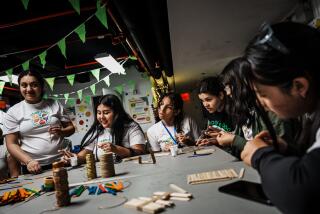Learning a Life’s Lesson : Hoover High students who delivered food and clothing to a poor Mexican village prepare a book about the journey and discover that they returned richer.
Even now, almost a year after she traveled to Mexico to take food and clothes to a starving Indian village where children were dying, 17-year-old Monica Herrada divides her life into two categories, pre-trip and post-trip.
The pre-trip Monica, she said, was uninvolved, uninspired and “selfish, I guess.” The post-trip Monica became president of her high school’s Latino students club and wants to join an international volunteer organization someone told her about. “It’s called the Peace Corps,” she said. “Have you heard of it?”
Gazing at the world through the scratched, weary lenses of adulthood, it is easy to forget what it feels like to be young and to see, do or hear something that suddenly, with a fantastic burst of clarity, transforms the way you look at the world and your place in it. Sometimes, if we are lucky, we can look back and recognize the epiphanies that changed us.
For Monica and seven classmates from Hoover High School in Glendale, a 10-day journey to the harsh high-desert home of the dwindling Tarahumara tribe last Easter may prove to be such a pivotal event. Energized by their experiences among the Tarahumara, they are raising money to publish a book about their adventure.
The students are not so naive as to think that their slim, 56-page volume, entitled “Discovery of Destitution,” will save either the Tarahumara or the homeless people in Hollywood they interviewed to round out the project. Their aim is far more subversive.
They want to prove that teenagers possess a deep capacity for change and compassion, given the chance and the right tools.
“I’m hoping that people get a better perspective on what high school students can do as opposed to what they are expected to do,” said Stephen Sotomayor, 17, a senior who did not go on the trip but helps oversee fund-raising for the $3,000 book project.
The stories the Glendale teenagers tell of the proud, suffering people they encountered in the Sierra Madre make it easy to see why the trip affected them so. The trip to Samachique was not postcard-perfect. There were setbacks that left the students more cynical, but also more confident in their own abilities.
An old tribeswoman asked if Monica would take a frightened little girl, whom the woman could no longer afford to feed, back to California. A boy, meanwhile, gave Jennifer Fors, 17, a new perspective on the physical comforts she took for granted. Shoeless, wearing only a T-shirt and torn jeans, he tried to warm himself by a dead fire as Jennifer stood nearby, miserably cold though bundled in two pairs of socks, two shirts, a sweater and jacket.
Armen Sarajian, 18, a senior, said he drew spiritual renewal and a “much-needed sense of worth” from a village leader who invited him to beat the ritual drums in an Easter ceremony.
“I think it’s pretty ironic that some kid from Glendale, Calif., who has never known much more than his own world could find the meaning of his life in some remote village,” Armen wrote in his contribution to the book.
The odyssey began in the art appreciation class taught by Pierre Odier, chairman of Hoover’s fine arts department. A bearded iconoclast who has worked at Hoover for 30 years, Odier tries to stimulate the consciences and interests of his students by exposing them to cultures and conditions different from their own. In past years, he has journeyed with his students to West Africa and the Arctic.
In January 1995, Odier brought in photographs and news articles depicting the plight of the Tarahumara, a tribe that ekes out a subsistence by hunting and gathering in the rough mountains of Chihuahua state in northern Mexico. A severe drought threatened the dwindling tribe with mass starvation. Babies were dying of malnutrition.
Before long, the students had organized collection drives to pay for the $9,000 trip and secure the clothes, food, medicine, toys, farming tools and school supplies they hoped to take to Mexico. Other students scoffed at their requests for donations and “insisted that our project would be a failure,” said Gabriela Gonzalez, 17.
But by the first day of spring break four months later, they had a truck packed with four tons of donated goods ready to head to the border. More obstacles soon appeared, each one providing yet another lesson of a harsh world.
Although the group had contacted border authorities in advance to pave the way for a smooth crossing, Mexican officials impounded the truck when they got to Ciudad Juarez, across the Texas border, and accused the students of planning to sell their load in Mexico.
The Hoover students were also unprepared for the corruption they saw in Mexico. They had written to a priest running a mission who had promised to help distribute the goods. But when they met with him, the priest insisted they give him money instead, claiming he had already collected contributions to buy food for the Tarahumara. The students said they would distribute the goods themselves.
In Samachique, the group set up a distribution center in an abandoned jail. As word spread of the strangers bearing food, people came from miles around. A small crisis erupted when Mexican loggers who worked nearby lined up for a handout and pushed the Indians to the back. The students went directly to the back of the line but their supply ran out long before they filled all the outstretched hands.
Crushed, the students gave away their own possessions. Monica pulled the Nikes off her feet. Karen Park gave her baseball cap to a little boy.
Once the students decided to publish their book, they sent a team to interview and photograph homeless people in Hollywood for a comparative study. Several students who conducted those interviews said that, like their classmates who went to Mexico, they found venturing into an unknown realm of society eye-opening.
The students are taking orders for the $10 book. Monica, like the others, is grateful for the chance to work on it. She says it helps keep her memories from Samachique alive.
More to Read
Sign up for our Book Club newsletter
Get the latest news, events and more from the Los Angeles Times Book Club, and help us get L.A. reading and talking.
You may occasionally receive promotional content from the Los Angeles Times.






